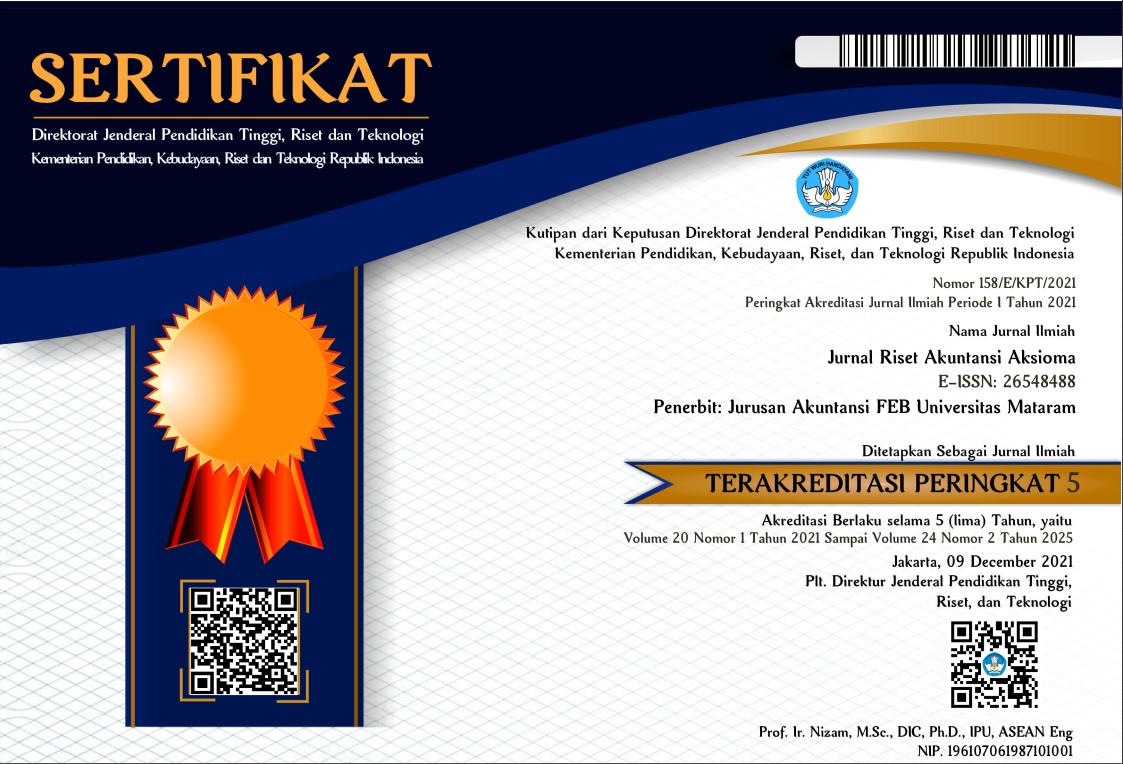CLASSIFICATION SHIFTING PADA PERUSAHAAN YANG TERINDIKASI FINANCIAL DISTRESS
Abstract
Penelitian ini bertujuan untuk menguji secara empiris manajer perusahaan yang terindikasi financial distress cenderung memindahkan beban inti menjadi other comprehensive income serta manajer perusahaan yang terindikasi financial distress lebih cenderung mengganti beban inti menjadi other comprehensive income sebagai tolok ukur laba. Sampel yang digunakan dalam penelitian ini adalah semua perusahaan manufaktur go public di Bursa Efek Indonesia yang terindikasi mengalami financial distress. Berdasarkan purposive sampling diperoleh sampel sebanyak 110 perusahaan. Alat analisis yang digunakan adalah metode OLS (Ordinary Least Square). Hasil penelitian menunjukkan bahwa koefisien interaksi OCIi,t* DISTRESS i,t-1 positif artinya manajer pada perusahaan yang terindikasi financial distress cenderung melakukan expense shifting.
References
Barton, J. and Simko, P. J. 2002, “The Balance Sheet as an Earnings Management Constraint”, The Accounting Review, Vol. 77 No. Supplement, pp. 1-27.
Charitou, A., Lambertides, N. and Trigeorgis, L. 2007a, “Earnings Behavior of Financially Distressed Firms: The Role of Institutional Ownership”, Abacus, Vol. 43 No. 3, pp. 271-96.
Charitou, A., Lambertides, N. and Trigeorgis, L. 2007b. “Managerial Discretion in Distressed Firms”, The British Accounting Review, Vol. 39 No. 4, pp. 323-46.
Chiorean, Raluca. Kirschenheiter, Michael and Ramakrishnan, Ram. 2017. Earning Management trough OCI Components. SSRN. Electronic copy available at: https://ssrn.com/abstract=2947818. Download 15 Maret 2018
Cooper, D.R. dan Schindler, P.S. 2014. Business Research Methods. New York: McGraw-Hill
Dichev, I. D. and Skinner, D. J. 2002. “Large-sample Evidence on the Debt Covenant Hypothesis”, Journal of Accounting Research, Vol. 40 No. 4, pp. 1091-1123. Elliott, J. A. and Shaw, W. H. (1988), “Write-offs as Accounting Procedures to Manage Perceptions”, Journal of Accounting Research, Vol. 26 No. Supplement, pp. 91-119.
Fan, Y., Barua, A., Cready, W. and Thomas, W. 2010, “Managing Earnings using Classification Shifting: Evidence from Quarterly Special Items”, The Accounting Review, Vol. 85 No. 4, pp. 1303-23.
Garcia Lara, J. M., Garcia Osma, B. and Neophytou, E. 2009. “Earnings Quality in Ex-post Failed Firms”, Accounting and Business Research, Vol. 39 No. 2, pp. 119-38.
Gunny, K. A. 2010. “The Relation between Earnings Management using Real Activities Manipulation and Future Performance: Evidence from Meeting Earnings Benchmarks”, Contemporary Accounting Research, Vol. 27 No. 3, pp. 855-88.
Habib, A., Bhuiyan, B. and Islam, A. 2013. “Financial distress, Earnings Management and Market Pricing of Accruals during the Global Financial Crisis”, Managerial Finance, Vol. 39 No. 2, pp. 155-180.
Haw, I. M., Ho, S. S. M. and Li, A. Y. 2011. “Corporate Governance and Earnings Management by Classification Shifting”, Contemporary Accounting Research, Vol. 28 No. 2, pp. 517-53.
Hodgson, A. and Clarke, P. S. 2000. “Accounting Variables and Stock Returns: The Impact of Leverage”, Pacific Accounting Review, Vol. 12 No. 2, pp. 37-64.
Jaggi, B. and Lee, P. 2002. “Earnings Management Response to Debt Covenant Violations and Debt Restructuring”, Journal of Accounting, Auditing and Finance, Vol. 17 No. 4, pp. 295-324.
Janes, T. D. (2003), “Accruals, Financial Distress, and Debt Covenants”, Doctoral Dissertation, University of Michigan.
Johnson, P. M., Lopez, T. J. and Sanchez, J. M. (2011), “Special Items: A Descriptive Analysis”, Accounting Horizons, Vol. 25 No. 3, pp. 511-36.
Kartikahadi, Hans. Sinaga, Rosita Uli. Syamsul, Merliyana dan Siregar, Sylvia Veronica. 2012. Akuntansi Keuangan Berdasarkan SAK Berbasis IFRS. Penerbit Salemba Empat
Lin, Wang and Rong, Men. 2012. Impacts of Other Comprehensive Income Disclosure on Earning Management. Nankai Business Review. 3 (1). pp. 99 - 101
Lougee, B. A. and Marquardt, C. A. 2004. “Earnings Informativeness and Strategic Disclosure: An Empirical Examination of “Pro forma” Earnings”, The Accounting Review, Vol. 79 No. 3, pp. 769-95.
McVay, S.E. 2006 “Earnings Management using Classification Shifting: An Examination of Core Earnings and Special Items”, The Accounting Review, Vol. 81 No. 3, pp. 501-31.
Malikov, Kamran. Manson, Stuart and Coakley, Jerry. 2017. Earning management using classification shifting of revenues. The British Accounting Review.
Nagar, Neerav and Sen, Kaustav. 2017. "Do financially distressed firms misclassify core expenses?", Accounting Research Journal. 30 (2). 205-223
Nakano, Makoto and Joon, Chae Soo. 2015. The Effect of Classification Shifting on Analyst Forecast Accuracy : Evidence From Japan. Hitotsubashi journal of commerce and management. 49 (1). 25 - 35Rosner, R. L. 2003. “Earnings Manipulation in Failing Firms”, Contemporary Accounting Research, Vol. 20 No. 2, pp. 361-408.
Roychowdhury, S. 2006. “Earnings Management through Real Activities Manipulation”, Journal of Accounting and Economics, Vol. 42 No. 3, pp. 335-70.
Siu, D. T. L. and Faff, R. W. 2013. “Management of Core Earnings using Classification Shifting around Seasoned Equity Offerings”, Working Paper, SSRN.
Subramanyam, K.R. and Wild, Jhon J. 2010. Analisis Laporan Keuangan. Salemba Empat.
Zang, A. Y. 2012. “Evidence on the Trade-off between Real Activities Manipulation and Accrual-based Earnings Management”, The Accounting Review, Vol. 87 No. 2, pp. 675-703.
Winarno, Wing Wahyu. 2011. Analisis Ekonometrika dan Statistika dengan EVIEWS. Edisi Ketiga. Yogyakarta : Unit Penerbit dan Percetakan (UPP STIM YKPN).
Worthy, Ford S .1984. Manipulating Profits: How It Done. Fortune, June 25, 50-54.
Wulandari, Soliyah dan Kusuma, Indra Wijaya. 2013. Manajemen Laba Dengan Classification Shifting: Pengujian Laba Usaha Dan Pos Luar Biasa (Studi Empiris Di Negara-Negara Asean). Jurnal Akuntansi dan Keuangan Indonesia. 10 (1). 1- 19
www.bapepam.go.id
www.idx.co.id
www.sahamok.com




















